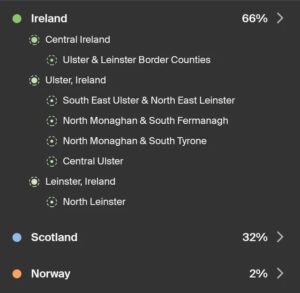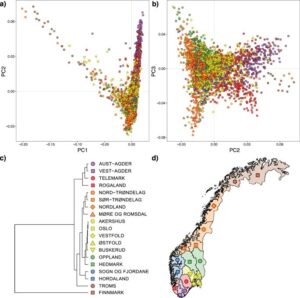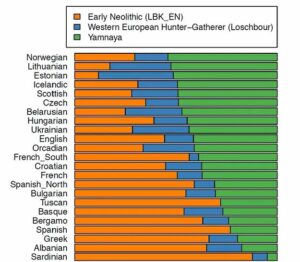Norway Ethnicity on Ancestry DNA
Have you ever thought of exploring your Norway ethnicity on Ancestry DNA results? If yes, then you are among the population of millions of people who are in North America, a part of the Norwegian evacuation. Even if you are expecting to find some percentage of Norwegian data in your DNA results, let’s learn some facts and find a perspective on Norway DNA Ethnicity through this blog.
A brief introduction on Norway’s Genetic Heritage
– Norway’s genetic make-up is an exciting composition of early migrations, ancient interactions, and present day influences.
– Through advances in genetic testing and research, we can now go deeper into the intricacies of Norway DNA ethnicity.
Explaining Norwegian DNA
So what does it mean to have Norwegian DNA? The genetic composition of Scandinavian people, including native people of Norway ethnicity region on ancestry can relate their genetic makeup primarily to early migrations to the region.
The first migration is also the founding stage of Norway DNA Ethnicity. This consists of tribes including German people who could settle in the area as ice started to diminish to show inhabitable land.
The second main migration was recently discovered. It consists of groups of people coming in this region all from the North East because migration was made possible due to melting of ice in the last phases of ice ages.
All though these two are the foundation of formation of the majority of Scandinavians people, but later migrations from the other parts of Europe also contributed to genetic composition. This concludes that most of the Scandinavians would share common ancestry with original inhabitants.
The Origination of Norwegian DNA
Early Migrations: Norway’s genetic landscape has been affected by many waves of migration, including the early hunter-gatherers who came after the Ice Age at the end.
Scandinavian Tribes: The migration of Germanic tribes, such along with Vikings, played an important role in shaping Norway’s genetic diversity, contributing to its unique ethnic composition.
Medieval Impacts: Interactions with neighboring areas, such as the Sami people in the north and the Finnish populations in the east, have also left their mark on Norway DNA Ethnicity and heritage history.
Genetic Diversity in Modern Norway
– Regional Variations: Although Norwegians share a large amount of genetic similarities, there are nevertheless noticeable regional variations that are a result of past migrations and patterns of settlement.
– Urban vs. Rural: Because of migration and intermarriage, urban centers may show greater genetic variety, whereas rural areas might continue to have a more uniform genetic profile.
– Recent Migrations: Norway’s recent past of immigration has contributed further Norway DNA ethnicity, especially in cities like Oslo where many different cultures coexist.
Is My Norwegian Ancestry Traceable?
Discovering the precise way in which you received your Norwegian DNA may pick your interest if you’re interested in Norway ethnicity on ancestry and family tree history. You should start working on a family tree if you want to know how you obtained the Norway DNA ethnicity in your results. Following your selection of the website to utilize for creating your family tree, you should do the following simple actions:
- To begin, add your parents, grandparents, and yourself to your family tree.
- Look through the US Federal Census records back as far as you can to find your grandparents, great-grandparents, and great-great grandparents among others.
- Finding your ancestors who traveled to North America is your first task. The language that your ancestors used on the census, as well as their place of birth and the place where their parents were born, should all be carefully examined because you may find this information on census records. You may find all the information you require to begin your investigation in Norway here.
There are a few key points to be aware of while using Norwegian documents to trace Norway DNA Ethnicity in the family tree. Because every nation has a unique history and culture, there are study suggestions that are location-specific and useful to know when planting a tree.
What is the ancestor’s position in the tree who passed on 2% of the DNA?
What is 2% Norwegian DNA? When estimating the depth of our Norway DNA Ethnicity results, there is a general “rule of thumb” that we might use. To identify the ancestor that carried on our 2% DNA area, we must search through our family tree. This general rule is based on the autosomal DNA inheritance pattern, which states that 50% of each parent’s DNA is inherited by their progeny. Recombination is the process that results in just 50% of an individual’s DNA being handed on to their offspring. Each and every human has two copies of each chromosome.
DNA Testing’s Significance for Comprehending Norwegian Ethnicity
Norway DNA Ethnicity Ancestry Testing: Thanks to developments in DNA technology, people now more precisely investigate their genetic heritage and find links to extinct populations and historical migrations.
Population Studies: Genetic studies on Norway ethnicity on ancestry percentage have given light on patterns of migration and interbreeding across millennia, offering important insights into the demographic history of the nation.
Health Implications: Knowledge of Norway’s population’s genetic variety is useful in areas like personalized medicine and illness research in addition to being of academic interest.
How did my DNA results show that I am Norwegian?
Why do I have Norway in my DNA? To find this answer, continue reading. There are numerous ways that the Norway ethnicity region could find its way into our genetic makeup. In order to find out about our Norway DNA Ethnicity relationships with other countries in the Norway DNA region and the degree of immigration from that region to the regions where our ancestors lived, we occasionally need to conduct research on the nations where our ancestors resided.
For instance, my great-great parents were born in the late 1800s in Holland. Nearly 100,000 Norwegians emigrated to what is now the Netherlands between the years 1700 and 1800 in quest of better economic possibilities.
Read More At:
- Paternity DNA Test In Nigeria : Price, Accuracy
- Top 10 DNA Test Kits For Siblings in 2024?
- How to Get a DNA Test While Pregnant
- How To Do A Dna Test At Home With Hair?
Obstacles & Things to Think About:
– Ethical Concerns: As genetic testing becomes more widely available, arguments regarding the ethical implications of genetic research have been sparked by worries about permission, privacy, and the possible exploitation of genetic data.
– Cultural Sensitivity: It’s critical to approach the research of Norway DNA Ethnicity with consideration for other people’s cultures, understanding that a person’s genetic heritage is only one facet of their identity and does not determine their sense of cultural affiliation or belonging.
When assessing your estimated ethnicity, consider the following three recommendations:
- The rule of thumb might be applicable in your particular situation; check to see whether it corresponds with your known family history.
- It is possible to have Norwegian ancestry on both ends of your family.
One’s Norway DNA Ethnicity location may have originated earlier than commonly thought and may have been transferred down in unequal amounts (i.e., not “halved” every generation).
Let’s look at some Researched Data
Fig- Genetic makeup of Norway
The above figure shows what dna do norwegians have based on few research studies.
 Fig- 2% Norwegian DNA on AncestryDNA results
Fig- 2% Norwegian DNA on AncestryDNA results
The above figure shows the 2% Norwegian DNA of a person on AncestryDNA.
| Ethnic groups | Percentage of population (approx) |
| Norwegian | 85% |
| Sami | 2-3% |
| Other European | 10% |
| Others | 2-3% |
Table- Based on various research data above ethnic groups have a percentage of population.
Fig- Norway roots in Ancient DNA
The picture shows study of ancient DNA which takes to roots of Norwegian DNA. They have a high incidence of Yamnaya genes.
Conclusion
Norway DNA Ethnicity is a complicated tapestry due to migrations for centuries, interaction between the groups and their adaptations to the environment. If we look through the lens of genetic research we may get deep into the rich diversity that affects the population of Norway and overall the global human family. In conclusion, investigating Norway’s DNA ethnicity reveals a complex mosaic of genetic variety entwined with the tales of the nation’s history and culture.
Although most Norwegians may trace their origins to the original Scandinavian populations, the Sami people’s existence emphasizes the complex interactions amongst Norway’s various ethnic groups. In addition, the centuries-long influx of many European populations has added to the patchwork of genetic backgrounds that exists in Norway today.
But it’s important to approach DNA ethnic origin thoughtfully and sensibly, realizing that a person’s genetic heritage is only one facet of who they are. A person’s sense of identity and belonging is also shaped by their cultural background, life events, and external influences. In order to create a society that is peaceful and cohesive, it is still crucial to embrace variety and promote inclusivity.
It’s critical to treat research findings with compassion and respect for the complexity of human identity as DNA ethnicity research develops. We may make progress towards a more accepting and understanding world by embracing our diversity and recognizing the humanity that connects us all.



